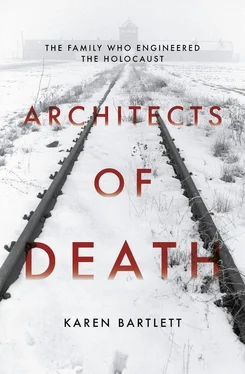These were the years of Germany’s explosive industrialisation and the development of a bourgeois middle class, in love with the idea of technology and progress. In Prussia, coal production increased fourfold between 1849 and 1875, raw iron output increased fourteenfold and steel output increased 54-fold. Firms which would become synonymous with German technology and manufacturing, including Hoechst, Bayer and BASF, were founded and flourished – while the workforce employed by industrialist Alfred Krupp rose from sixty men in 1836 to 16,000 in 1873.
Essayist Otto Gildemeister wrote in 1873: ‘It is not exaggeration to say that when it comes to trade and communications and industry, the gulf that separates 1877 and 1773 is greater than the gulf separating 1773 and the Phoenicians.’ [7] Blackbourn, op. cit., p. 205.
Historian David Blackbourn claims that while this is an exaggeration, it is one that sums up the spirit of the time. In the towns and provinces across Germany, small businessmen were buoyed by a ‘mushroom-like growth’ of factories, gasworks, waterworks and railways. A particular area of prosperity related to food production and milling and brewing – fortuitously for Topf and Sons, as this was their line of business.
While J. A. Topf had not been able to seize these advantages himself, the years between 1885, when the Topf brothers refounded the business, and the turn of the twentieth century would lay the foundations for its future commercial success. Two other brothers, Albert and Gustav, joined the firm, strengthening its prestige in the case of Gustav who, as a chemist and biologist, set up an on-site laboratory to test innovative machinery. The company would also enter into a series of successful business partnerships that would enable it to expand and prosper. The first of these saw Erfurt’s oldest metal processing firm, J. A. John and Company, take over the processing, invoicing and supply for all Topf products. Within the course of a few years, commercial success meant that Topf and Sons expanded, adding malt kilns to their range, and moving premises four times before finally building their own works and administration building outside the town near the railway station.
From 1889 onwards, this site in Daberstedter Feld (now called Sorbenweg) was the seat of the company – and it was where Topf would continue to operate from until the end of the Second World War. At first the administration building held an office on the ground floor, and accommodation for the Topf family above. The site also contained production facilities, a goods shed and a place for workers to wash and change. The Topf brothers had chosen well; Erfurt had been defortified since the founding of the German Reich in 1873, opening up new areas of land and increasing industrial development. During these decades, the population of Erfurt doubled and the town was given city status in 1906.
The deaths of Albert and Gustav Topf, in 1893 and 1896 respectively, meant that Julius and Ludwig Topf would co-run the company for the next eight years. Within three years the company had started producing its own equipment, and formed a new manufacturing partnership with master mill builder Reinhold Matthias, which it would later take over in its entirety, and Beyer and Co., a machine factory that concentrated on steam driven machines. Topf and Sons also bought into, and later took over, a relative’s company, Topf and Stahl, which sold malting and ventilation equipment. Internally J. A. Topf and Sons was now divided into a malting division and a boiler equipment division, and employed fifty fitters. This period of rapid expansion, consolidation and success was symbolised by the decision in 1899 to register a trademark in which the letters of the name Topf formed a pot (Topf means pot in German). In time, of course, this trademark would become infamous.
After several successful years, Julius Topf decided to step down from his role in the business on 1 January 1904. Citing ‘ill-health’ he dedicated his remaining time to his love for fruit tree cultivation, and his work on the city council and as a freemason. By now he had had nine children with his wife Babette, including his son Albert, who would become Hartmut Topf’s father. The family had now moved from the Topf site to their own home at 4 Nonnerain, where they would play only a peripheral role in the history of the company.
As of 1904, Topf and Sons was now under the sole control of Julius’s brother Ludwig Topf Sr – and eventually his heirs. Julius’s decision to step down from the business coincided with the birth of Ludwig Sr’s first son, who was christened Viktor but always known by his third given name, Ludwig. In 1901, the then 38-year-old Ludwig Sr married a woman nineteen years his junior, Pauline Else Getrud Kuhnlenz, known as Else. They celebrated their wedding with a company party and a newsletter that showed the couple surrounded by flaming hearts on one side and pictures of the Topf and Sons works on the other. Their first child, Johanna, was born the following year in 1902, followed by Viktor Karl Ludwig in 1903 and then Ernst Wolfgang in 1904.
As the wedding/works party demonstrated, the lives of the Topf family were now bound up with the success and prestige of the company, and the new generation of Topf children began their lives in the accommodation quarters of the Topf administration building. Ernst Wolfgang would later say that he had been born and bred at ‘J. A. and Topf’s machinery factory’. By now, however, Ludwig Sr had become one of the seven wealthiest businessmen in Erfurt, earning a salary of 10,000 Reichsmark per annum (more than ten times what a working-class carpenter or miner would have made at the time) as well as a share of the company profits. By 1909, the family had moved out of the administration building into a rented apartment in the city centre, but Ludwig Sr was determined that his children would not be spoilt by wealth, and insisted that they visit workers’ homes and hospitals – dispatching the young Ludwig to spend his summer holidays with a worker’s family where he even had to share a bed with a boy the same age.
Ludwig Sr’s one extravagance was to establish a ‘summer residence’ – on an area of parkland only a ten-minute walk from the factory. Topf built a house on the land between Hirnzigenweg, Rubensstrasse and Wilhelm-Busch-Strasse, and then created a string of allotments around the edge of the park to be used by Topf and Sons’ workers. The allotments were in keeping with a movement of the time where workers were encouraged to cultivate small plots of land, grow their own vegetables and relax. It also shows a strong bond between the Topf family and their workers that extended far beyond the work of the factory floor. Ludwig Sr set up a staff pension fund, introduced Christmas bonuses and built a non-profit housing cooperative. At the firm’s twenty-fifth anniversary celebration in 1903, he announced that he considered himself, and his brothers, to be ‘the company’s first workers’ and, in response, Topf furnace builders presented Ludwig Sr with a silver goblet with depictions of the Topf family and their workers. At the presentation one worker recited a poem he had written, proclaiming that he hoped both the tankard and Topf and Sons would survive for 1,000 years.
For the next decade Ludwig Sr fully lived the life of a prosperous early twentieth-century businessman: he was both a board member of the Thuringian Industrialists Society and vice-president of the Erfurt chamber of commerce. His company, Topf and Sons was able to take advantage of a stable political climate and a boom in German beer brewing, and grew to become a mid-sized business of 517 employees by 1914. Topf and Sons was now the global leader in producing malting systems, selling high-quality patented products through an international sales network that stretched to fifty countries, and with technical offices across Germany and in Poland, Austria and Belgium.
Читать дальше












